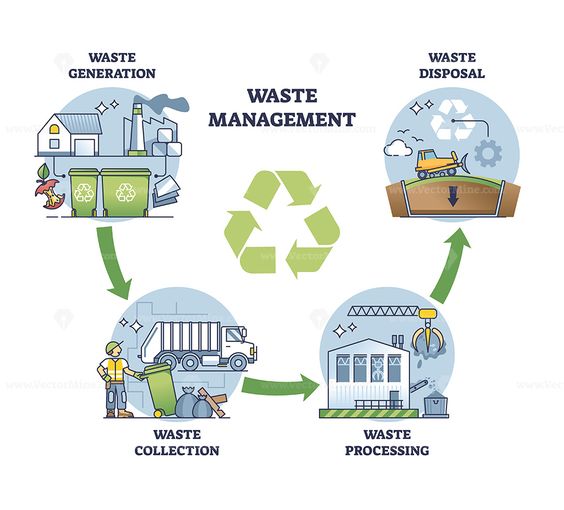
Step-by-Step Guide for Businesses To Build Effective E-Waste Management System
Electronic devices have become an integral aspect of our daily lives in an era dominated by technology. However, rapid technological advancement has also given rise to a significant environmental issue: electronic waste (e-waste). To address this issue and contribute to a sustainable business environment, businesses must develop effective e-waste management systems. This comprehensive guide outlines vital strategies, best practices, and innovative solutions to help companies navigate the complexities of electronic waste disposal.
Steps To Establish an Effective E-Waste Management System
Step 1: Assess Current E-Waste Generation and Disposal Practices
Before developing an e-waste management system, businesses must thoroughly assess their current e-waste generation and disposal practices. It includes identifying the types and quantities of electronic equipment used, understanding the end-of-life management processes in place, and evaluating existing contracts with waste disposal vendors.
- Conduct a comprehensive inventory of electronic equipment, including computers, printers, monitors, and other devices.
- Analyze past disposal practices and identify areas for improvement.
- Review contracts with waste disposal vendors to ensure compliance with environmental regulations.
Step 2: Develop an E-Waste Management Policy
Establishing a clear and comprehensive e-waste management policy is essential for guiding employees and ensuring the organization’s commitment to sustainability. The policy should outline guidelines for the proper disposal of electronic equipment, promote responsible consumption, and emphasize the importance of recycling.
- Involve key stakeholders in policy development, including employees, environmental health and safety teams, and procurement departments.
- Clearly communicate the policy to all employees through training sessions and informational materials.
- Regularly update the policy to reflect changes in technology and regulations.
Step 3: Educate Employees on E-Waste Management
Employee awareness is a critical component of successful e-waste management. Training programs should educate employees on the environmental impact of e-waste, the importance of recycling, and the proper procedures for disposing of electronic equipment.
- Conduct regular training sessions on e-waste management for employees at all levels.
- Implement a communication plan to reinforce the organization’s commitment to sustainability.
- Encourage employees to report damaged or obsolete electronic equipment for proper disposal.
Step 4: Implement a System for Electronics Recycling
Establishing a system for recycling electronic equipment ensures responsible disposal and minimizes the environmental impact of e-waste. Collaborate with certified e-waste recycling facilities to handle the recycling process.
- Identify reputable e-waste recycling partners with proper certifications.
- Establish collection points within the organization for employees to return old or obsolete electronic devices.
- Implement a secure data destruction process to protect sensitive information before recycling.
Step 5: Monitor and Measure E-Waste Management Performance
Regular monitoring and measurement are crucial for assessing the effectiveness of the e-waste management system. Implement key performance indicators (KPIs) to track e-waste generation, recycling rates, and compliance with regulations.
- Establish KPIs related to e-waste generation, recycling rates, and cost savings.
- Regularly audit e-waste management processes to ensure compliance.
- Use data analytics to identify areas for improvement and optimize the system continuously.
Step 6: Stay Informed about Regulatory Compliance
E-waste management is subject to various local, national, and international regulations. Stay informed about evolving regulatory requirements to ensure compliance and mitigate legal risks associated with improper disposal.
- Assign responsibility for monitoring and staying updated on e-waste regulations to a dedicated team or individual.
- Establish a comprehensive system for documenting regulatory changes and compliance requirements.
- Conduct periodic audits of your e-waste management practices to verify compliance with the latest regulations.
Step 7: Encourage Circular Economy Practices
Promote a circular economy approach by implementing practices that extend the lifespan of electronic devices and reduce overall consumption. This approach involves refurbishing, repairing, or upgrading electronic equipment to maximize utility before disposal.
- Establish a system for refurbishing and upgrading electronic devices within the organization.
- Encourage the purchase of modular and easily repairable electronic products.
- Explore partnerships with manufacturers that support circular economy principles.
Step 8: Engage Suppliers and Vendors in E-Waste Management
Collaborate with suppliers and vendors to ensure they share your commitment to responsible e-waste management. Include clauses in procurement contracts that prioritize environmentally friendly product design, recycling practices, and responsible end-of-life disposal.
- Integrate e-waste management criteria into supplier selection processes.
- Encourage suppliers to adopt sustainable packaging practices to minimize additional waste.
- Regularly assess and communicate expectations regarding e-waste management to vendors.
Step 9: Engage in Corporate Social Responsibility (CSR) Initiatives
Integrate e-waste management into your corporate social responsibility initiatives. Participate in community awareness programs, sponsor e-waste collection drives, or collaborate with local organizations working towards environmental sustainability. Demonstrating a commitment to responsible e-waste practices can enhance your brand’s reputation and positively impact the communities where your business operates.
Final Part
Developing an effective e-waste management system requires a comprehensive approach that involves employees, certified recyclers, and strategic planning. By implementing the steps outlined in this guide, businesses can contribute to a sustainable business environment, comply with regulations, and enhance their corporate social responsibility. Embracing responsible e-waste management benefits the environment and establishes a positive image for the organization in the eyes of customers, partners, and employees.
Follow Us:







